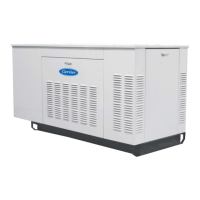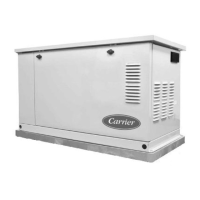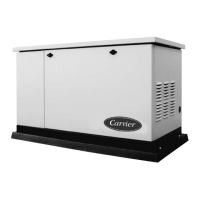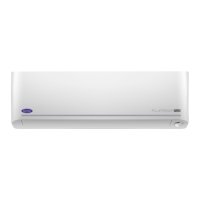Do you have a question about the Carrier ASPAS1CCA007 and is the answer not in the manual?
Emphasizes the importance of reading the entire manual before use.
Outlines the structure and topics covered in the manual.
Highlights the owner's responsibility for safe operation and upkeep.
Provides guidance on contacting dealers for service and repairs.
Crucial safety rules for installation, operation, and servicing of the generator.
Covers essential safety precautions for operating the generator, including exhaust and moving parts.
Details risks associated with high voltages and electrical shock prevention.
Provides guidelines for fire safety, including installation and extinguisher use.
Warns about explosive fuel gases and necessary precautions.
Lists relevant industry standards for equipment installation.
Instructions for inspecting the generator set and its enclosure upon delivery.
Describes the built-in systems designed to protect the generator from damaging conditions.
Explains the National Electric Code requirement for AFCI breakers in dwelling unit bedrooms.
Identifies key components and visual features of the 7 kW generator model.
Provides detailed technical specifications for the generator models.
Explains the function of the System Set LED indicator on the control panel.
Outlines requirements and recommendations for natural gas and LP fuel usage.
Details fuel consumption rates for natural gas and LP vapor at different load levels.
Provides guidance on selecting an appropriate outdoor location for generator installation.
Instructions on how to safely lift and handle the generator unit.
Guidelines for installing the generator outdoors, considering air flow and environment.
Recommendations for installing the transfer switch indoors, ensuring protection.
Step-by-step instructions for correctly installing the generator's battery.
Safety precautions and handling guidelines for lead-acid batteries.
Recommended procedure for the initial run-in and testing of the generator.
Explains the operation of the AUTO/OFF/MANUAL switch for controlling the generator.
Describes the functionality of the AUTO position for automatic system operation.
Details the function of the OFF position, which shuts down the engine and prevents automatic operation.
Explains how to use the MANUAL position to start the engine manually.
Steps to select and initiate automatic operation of the generator system.
Information on using the 12 VDC outlet for low-power accessories, with usage warnings.
Details the location and use of the external 120 VAC GFCI convenience outlet.
Describes the step-by-step process the generator follows during automatic start-up and operation.
Procedure for manually transferring power to the generator or utility source.
Steps for manually starting the generator and transferring loads to standby power.
Procedure for transferring loads back to utility power and shutting down the generator.
Instructions on how to set the exercise timer for periodic generator testing.
Overview of the various protection systems that monitor and safeguard the generator.
Explains the function of the low oil pressure switch for engine shutdown.
Details the high temperature switch that initiates engine shutdown to prevent overheating.
Describes the over crank protection feature that prevents engine damage during starting attempts.
Explains the over speed protection that shuts down the generator if it exceeds a set limit.
Information about the generator's fuses, their purpose, and replacement procedures.
Step-by-step guide for checking and maintaining the engine oil level.
Instructions for performing engine oil changes, including recommendations and procedures.
Procedure for replacing the engine oil filter, including necessary steps.
Guidance on how to clean or replace the engine air cleaner element.
Instructions for inspecting, cleaning, gapping, or replacing spark plugs.
Procedures for inspecting and maintaining the generator's battery, including safety precautions.
Information on maintaining proper airflow for the generator's cooling system.
Recommendations for protecting the generator enclosure from corrosion.
Important steps to take if the generator has been submerged in water.
Steps for preparing the generator for extended storage and returning it to service.
A comprehensive schedule outlining required maintenance tasks and their frequencies.
A guide to identify and correct common problems encountered with the generator.
Details the terms and conditions of the manufacturer's two-year limited warranty.
Explains the specific warranty rights and obligations related to emission control systems in California.
Outlines the warranty coverage for emission-related parts on the engine.












